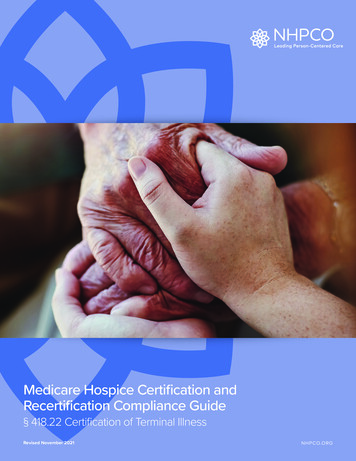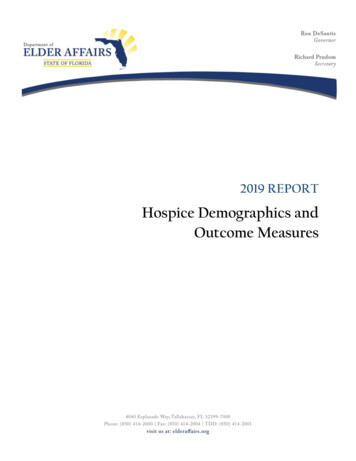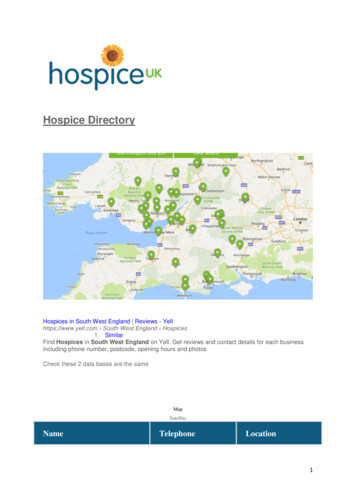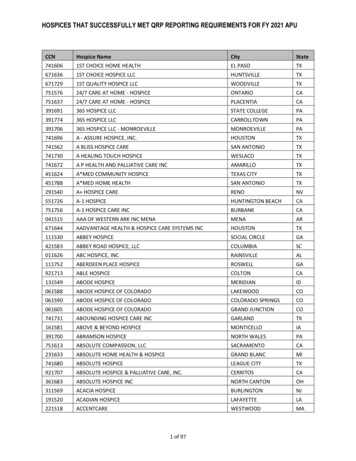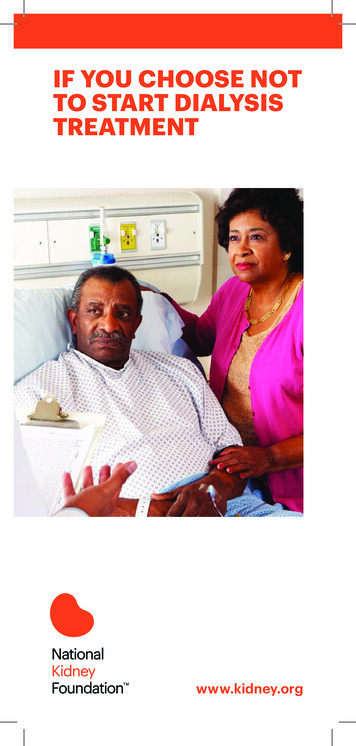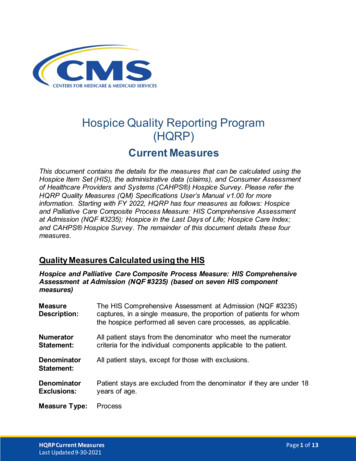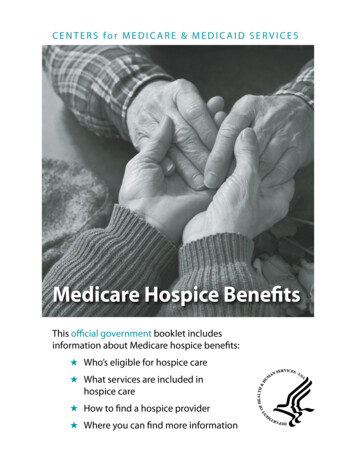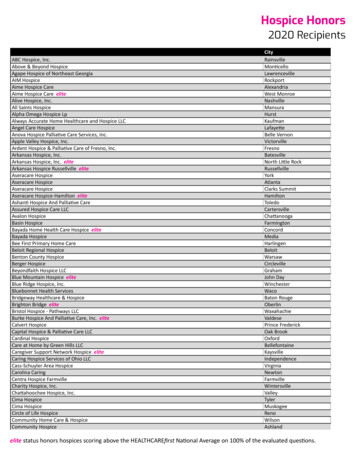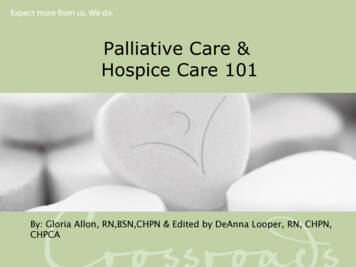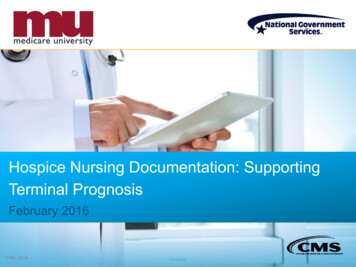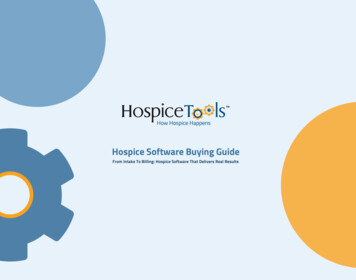
Transcription
Hospice Software Buying GuideFrom Intake To Billing: Hospice Software That Delivers Real Results
IntroductionDiscover comprehensive hospice software to simplifyhospice managementGiven the growth, regulation, and hypercompetitive nature of the hospiceindustry, having the right hospice software is more important than ever. Thisguide will help lay out what to look for and what to avoid when assessinghospice software.Despite technological advances, most hospice software is still cumbersomeand expensive and don’t deliver the promised results.Worse, many hospice software solutions are fragmented. For example, anEHR may have clinical charting but not have an integrated workforce management module or built-in billing solution. This fragmentation forces manyhospice companies to use a variety of solutions and vendors to meet theirneeds.The lack of cohesion between these fragmented solutions results in theadded expense of third-party solutions and dedicating internal resources tocompleting tasks manually.A great hospice solution should be more than just an EHR. Your softwareshould actually be a comprehensive hospice management solution designedto deliver significant ROI with measurable business benefits, such as
03Improved Client & Internal Communications:Improved Compliance –Communication is a critical component of a healthy business. That’sespecially true for healthcare service companies like hospice agencies. Your hospice software solution should deliver real-time access topatient information in order to respond to your clients’ needs instantlywith simplified internal communications, so your teams are always onthe same page.An essential component of an EHR system is that it should automatecompliance. Your hospice teams’ work flow and documentation mustby design, automatically match regulatory guidelines. For example, areyou still manually matching clinical visits to clinical times or worse,paying a 3rd party to manage that for you? A great EHR with a builtin workforce management solution integrated with clinical chartingwill automatically complete these previously manual, expensive, anderror-prone tasks. Would your agency survive an audit?But communication is about more than just patient care. Your software must easily manage financial issues like tracking patients accounts receivables and payments, referral source tracking for streamlined updates, and the ability to easily transmit patient and financialinformation to clients.Your hospice software should not only store documentation, it shouldalso provide granular access to the charts with safety features thatprotect your organization in an audit.Improved Change Management –Improved Financial Organization:A robust hospice software solution should organize your finances andmake billing simple. You shouldn’t have to pay third parties to do yourbilling. An integrated and well-organized financial system enables youto improve your ROI, maximize revenue and get paid faster.Improved Problem-Solving:Reporting & benchmarking tools in your software should gather keydata and enable you to discover, is there a problem, what is the problem, is it a people problem or a process problem. With proper reporting and benchmarking you will have the right information for problem-solving.1. Is there a problem?2. What is the problem?3. Is this a people problem or a process problem?Your reporting & benchmarking tools should then guide you to a quickand thoughtful resolution delivering the capabilities an agency needsfor improved problem-solving.Change is an elemental part of life and business. A comprehensivesoftware solution must also have the flexibility to seamlessly adapt tochange, whether it’s internal organizational change with new peopleor processes or external regulatory change. Tools such as customizable forms and global dashboards enable simple information flowmanagement, so work flows remain smooth and team members adaptquickly.The Right Software VendorThe software solution that runs your agency is also a partnership witha software vendor. While having the right feature set is important,partnering with the right software provider is too. The key componentthat determines if a software provider is a partner or just anothervendor is: Transparency. A solutions partner will be up-front and openabout issues such as: such as training, product features, and pricing.
Contents:Hospice Tools is built specifically for hospice andpalliative care agencies.A Comprehensive Hospice Software Solution5Critical Hospice Software Features8Deployment & Pricing11Testing & Pricing12Per-User vs. Census-Based Pricing13“Hospice Tools is intuitive and user-friendly. It has totallysimplified hospice management from top to bottom - frommanaging staff and patient care to improved complianceand billing, more than any EHR system I have used in thepast.”- CK, Hospice Admin
05A COMPREHENSIVE HOSPICE SOFTWARE SOLUTIONHealthcare is a massive field. What works and doesn’t work in an EHR for adoctor’s office, home health service, or hospital does not translate to hospiceand palliative care. The lack of focus and intuitive industry-specific tools iswhy some of the largest EHR vendors have the highest levels of customerdissatisfaction.Hospice software should be specific and focused on hospice & palliative care.These two areas of care are deeply intertwined. Many hospice agencies offerpalliative care or plan to add palliative care to their service. The software layout, features, and structure should be built by experts across the disciplinesof hospice and palliative care, clinicians, administrators, and back-office whowork hand-in-hand with in-house software engineers.When a hospice EHR is just another module of a large healthcare softwaresystem, such as a hospital EHR, resources such as developers are often focused on maintaining, updating, and continuing development on their biggermodules. And, support teams such as technical support and customer success are often more familiar with the hospital modules which have a greateruser-base than their hospice module.The problem of using a hospice solution that is simply an add-on module ofa larger system is similar to problems found in hyper-focused solutions. Forexample, an EHR built by nurses for nurses will often lack critical featuresthat the rest of your agency needs to operate smoothly. Nursing, while critical, is only one element in a thriving hospice agency.A comprehensive hospice software system must address the wide range ofhospice agency needs, clinical, non-clinical disciplines, administrative, andbilling.Customer service is a critical component in choosing a software vendor.Resolving IT issues, billing problems, technical issues and more are fundamental to the productivity and health of a hospice agency. Communicatingwith a sprawling software company for whom hospice is a small subset is akey factor in why so many agencies express dissatisfaction with their EHRsystems.
Hospice agencies have two sides; the business side and the clinical careside. A hospice software solution needs to address both sides for youragency run smoothly and efficiently.The hospice clinical side: Your software should deliver a balance ofrobustness with ease of use. Your hospice software should obviouslyhave the features and functions for clinical documentation and chartingespecially as it relates to patient care and compliance issues. Thesoftware should store clinical documents as well as being able to uploadexternal documentation directly into a patient’s chart. And, the datashould be updated in real-time for the seamless exchange of informationacross care disciplines.Importantly, your software must have a focus on ease of use while cuttingdown errors and improving processes. Care providers should not have tobe tech experts to be comfortable using their software. If your hospicesoftware requires more than 2-3 training sessions - and especially if itrequires on-going training, it has not been built for ease of use.The business of hospice: Your hospice software should seamlessly takeall that clinical data, clean it, prepare it, and process it for analytics,compliance, billing, and payroll. Each of these elements is critical tomaintaining a healthy hospice agency. Analytics allows you to find errorsand improve processes. Compliance is a requirement of a functioningagency. And compliance issues shouldn’t be a game of catch up, yoursoftware should seamlessly and automatically keep you in compliance,so you can focus on the business aspects of your agency. And, the moreaccurately and faster you can bill and get paid, the stronger your agencywill be.View Hospice ToolsPricing and Plans
07A COMPREHENSIVE HOSPICE SOFTWARE SOLUTION CONCLUSION: OneYour software should behospice & palliative carespecific. Not a moduleof a larger healthcaresoftware system. TwoYour vendor should bespecialized in hospice& palliative care andmanagement to get thefeatures and supportservices you may need. ThreeHospice softwarewhen done right is acombination of robustfeatures with easeof use - while alsobalancing clinical andbusiness needs. FourThe EHR running youragency should be easyto learn, easy to use,easy to store and shareinformation, and automatically maintaincompliance. Onboardingshould only take a fewsessions at most.
Critical Hospice Software FeaturesClinicalThe goal is to have the right mix of features for clinicians, non-clinicians, and admins. The software should be user-friendly,simplify processes, manage documentation and patients. The clinical portion of the software solution should be integratedwith workforce management tools and billing for streamlined back-office processes and automatic compliance. Referrals & intake: Easily manage and track referrals. Processorders and authorizations Intuitive point-of-care charting: Built by hospice pros tointuitively match your clinical work flow. Desktop & mobile app: Any system, any device, anywhere inreal-time Medications: Manage current meds, past meds, & multiplemeds\ Clinical tracking management: Built for Hospice & Palliativevisit tracking Full clinical documentation: Manage documentation withelectronic signing & approval work flow. Designed for everydiscipline: nursing, aides, social services, chaplain assessments,care plans, visit notes and more. Mentor mode: For non-credentialed, onboarding, interns, anddoctor review. Volunteer mode: Approval-based documentation for yourvolunteers Audit mode: Protect your agency from inadvertent data leaks inan audit Quality management: From referral through bereavementtrack trends & outcomes with actionable informationRisk Management - Track & compare data against benchmarksFocus QAPI with meaningful dataEasily export files for sharing, submission, and processing IDG: IDG Agenda Sheet cuts down meeting time. Review 100 patients in underthree hours!- Real-time IDG/IDT updates- Full clinical documentation available on any device, anytime, anywhere- Intuitive structure and navigation so IDG can see the comprehensive viewand focus on care plans- Easily access current and historical data across all disciplines Smart care planning: Intuitive & straightforward with suggestions for goals andinterventions- Real-time so your team is always on the same page- Pre-loaded library of smart plan options and seamlessly add itemsspecific to your plan- Easily updated and edited to personalize care Bereavement: Risk assessment and frequency of communications criteria Psychosocial & spiritual support: Charting tools and forms to support the needs ofsocial workers and chaplains- Ample categories identifying elements of spiritual strengths and distress- Clear language that is concise, contributing to the ease of the successfulcompletion of documentation- Sufficient flexibility that affords precise narrative describing patient spiritualneeds, goals, interventions and outcomes- Customizable Care Planning that allows the chaplain the use of a “pastoralvocabulary”- A varied choice of forms for documentation that are appropriate for thereporting needs of the chaplain
09BillingBilling tools should be easy to use, end error-prone and resourceintensive manual tasks, maximize revenue, and get you paid faster.Billing tools should handle hospice & palliative billing, all payersources, patient accounts receivables and operate as the full financialmanagement platform for your hospiceagency’s back-office. Easy Tracking: Uploaded files are easy to view.Downloaded file can be used immediately andchecked easily Batch Billing: Submit hundreds or thousands of claims with one click of abutton Full Patient Financial Tracking Daily Census Tracking Claim Generation Export Claims: For electronic or paper claims Revenue Management: Upload electronic remittances Payment Management: A seamless system for managing payments to skillednursing facilities Hospice & Palliative Care Billing Integrated: Data flows automatically from clinical documentation and timesheets for fast, accurate billing
Workforce ManagementWorkforce management tools should free up clinical and back-office staff with the goal of creating massive efficiencies and improvingcompliance. Time sheet creation should be easy to navigate with hospice specific activities. Time sheets should be integrated with clinicaland billing to deliver automatic compliance and simplify payroll and reporting. Intuitive and easy navigation: Virtually no training needed. Enter andverify data with easy drop-down menus. Hassle-free QA: Seamlessly linked to eDocs clinical documentation forsmooth automatic information flow Comprehensive timesheets: Designed for hospice agencies with timereporting, location, mileage, patient, activity type and more Automatic compliance: Integrated with eDocs to end fraud liability byinstantly matching time sheets to clinical visits Access anywhere timesheets: Built to match your work flow withdesktop access and mobile app Auto-build: Integrates clinical visit times and locations from clinicaldocumentation to auto-build time sheets with the click of a button Individualized dashboards: Time, Absent, PTO tracking tools Payroll: Automatically organized with easy reportingReporting and Analytics Doc Management Generates customizable forms for a variety of documentation, anyfield on any form.Fast insights: Drill down into the complexities of businessrevenue and expenses, such as billing, patient metrics, and keybusiness metrics. A library of forms for easy adaptation - not embedded in code Form functionality, validation, and form behavior & form creationCentral dashboards: Get insight and aid with problem-solvingand decision-making. Upload & place images and PDFs Export charts & individual docs Any field on any form: Adapt fields to your needs with rankings anddrop downs and pop-ups Error notifications: Correct documentation before submissionsIndividualized dashboards: Easy care team task anddocumentation management
11DEPLOYMENT & PRICINGIn today’s software world your hospice software solution should be cloud-based, not installed onpremise. On-premise systems are expensive, hard to switch away from, and typically require up-frontcosts for on-premise installation, as well as ongoing maintenance, and upgrades. Often an agency willneed an in-house dedicated team to manage the on-premise solution. Further, on-premise solutionsrequire an in-house data security plan and additional 3rd party solutions.Advantages of cloud-based solutions over software installed on-premise include: No/Minimal Installation: Cloud-based solutions are accessed through desktop web browsers andmobile apps. On-premise solutions must be installed by a technician and hosted on a local server. Updates are automatic ensuring that all team members are always using the most currentversion of the software. No/Minimal Maintenance issues: Dependence on IT staff is minimal with cloud-based solutionsas technical issues related to the software are the responsibility of the software provider.Software installed on-premise and hosted on your local server require in-house technical staff or3rd party consultants to resolve technical problems. Admin controls and other tools are managed through flexible dashboards that provide easy rolebased access which can be managed without technical expertise. Cybersecurity is superior: Many incidents of cybersecurity are related to employee negligence ordisgruntlement. Employees have no access to the cloud infrastructure where they could causeintentional or inadvertent damage to your agency’s data or infrastructure. Access anywhere: Clinical data may be accessed by desktop web browser and mobile appsanywhere, anytime. Information such as clinical charts is accessible and updated on all platformsin real-time. Compliance: Healthcare regulations change. Your software solution needs the flexibility to keepyou seamlessly in-compliance. On-premise solutions often require a significant investment intechnical expertise, upgrades, and maintenance to adapt to new scenarios. Cloud-based solutionsshould seamlessly adapt to new scenarios without the user incurring any additional costs. Conclusion:Cloud-based hospice software is the clear winner.
TESTING & PRICINGHospice software vendors are often behind the times when it comes to themethodology they employ in demonstrating their software. Most vendorsdo not provide videos of their products, self-service demos or free trials.Rather, they require a “discovery meeting” before then setting a date fora short demonstration. The goal of a discovery meeting is to find out theusers needs and then tailor a demonstration to fit that need. And if you havemultiple needs you will require multiple demonstrations.In actuality though, most of these demonstrations are one-size fits all. Thediscovery meeting, follow-ups, and screen-shared demonstrations aredesigned to require a greater and greater commitment of your time andenergy. The principle is, the more resources someone invests, the greaterthe likelihood they will choose our software. That is the attitude of a vendor,not a partner.A software solution delivered by a partner will provide the information upfront. The goal should not be to manipulate you into investing resources tolearn about the solution, but to deliver so much value that you choose tomove forward with the discovery process.The information a partner will provide even before a discovery meetingshould include: How-to videos Free trial/self-service demo Up-front pricingThen, having received the value, if you proceed into the testing scenario,the software provider should be there to support your trial of the product.However, the requirement of ‘discovery meetings’ and multiple screenshared demos will not deliver the value and information necessary to choosethe solution that will run your business.
13PER-USER VS. CENSUS-BASED PRICINGPer-user pricing simply makes sense. It allows you to budget and planaccordingly and conserves valuable resources.1. Your census changes all the time, don’t tie up your office staff reviewingyour vendor’s billing algorithm. Your hospice software should make youragency more efficient, not add another layer of complication.2. Census-based pricing is a penalty. If your hospice software helps makeyour agency more efficient and do more with the same resources, youshouldn’t pay more for that. For example, if your census increases from 25to 26, the cost of your software will increase by almost 60%. even if yourcare team hasn’t increased at all.3. Hospice is a hyper-competitive industry. Unless your agency is thelargest care provider in a given price-point, census-based pricing createsan uncompetitive ROI. Let’s say the census-based price point for 26-75patients is 1195 per month. If you have 26 patients your agency is payingthe same amount as an agency that has 75 patients. You should not bepaying the same amount as an agency that has a census count almostTRIPLE the number of patients in your agency.And while at a census count of 75 your agency has a competitive ROI, addone more patient to your count and now you’re at the bottom of the nextprice point with a huge price increase, even if you haven’t added a singleteam member!
AVERAGE CENSUS-BASED PRICINGMonthy UnduplicatedPatient CensusPrice per month0-25 750.0026-75 1,195.0076-100 1,795.00101-300 2,295.00301-400 2,995.00Let’s do the math:YOUR HOSPICE AGENCYYOUR COMPETITOR’SHOSPICE AGENCYCensus count26Census count75Employee head count10Employee head count20Price per month 1195Price per month 1195Cost per employee 119.50Cost per employee 59.75 Cost per employee: 119.50 - 59.75 59.75 price difference 59.75 price difference X 10 users X 12 months 7170 per year Your competitor has a higher census count, more users on thesystem, and pays half per-user for the same softwareCan your hospice agency afford the negative ROI of census-based pricing?
15PER-USER VS. CENSUS-BASED PRICING CONCLUSION Census-based pricing is a triple-threat to your business- Resources devoted to tracking bills for accuracy- A tax on efficiency by increasing costs based on increasing census- Uncompetitive ROI with larger agencies paying significantly lessper-user based on higher census count Flat per-user pricing makes sense. You simply pay for the users youneed. Your vendor should offer pro-rating should a user leave (fired, quit). Aswell as the ability to move an existing license to a new user (quit andnew hire). Your vendor should also be open to negotiating if you have specialrequirements for specific users, are a not-for-profit, VA, rural provideror other.I like most about Hospice Tools is“ Whatits ease of use, especially for documentation of visits and contacts.”- Palliative Nurse Practitioner
Start your FREEHospice Tools trial now! Give us a call:1-833-EHR-TOOLS (1-833-347-8665)
Hospice Tools is built specifically for hospice and palliative care agencies. A Comprehensive Hospice Software Solution. Critical Hospice Software Features Deployment & Pricing. Testing & Pricing Per-User vs. Census-Based Pricing. 5 8. 11 12. 13 Hospice Tools is intuitive and user-friendly. It has totally . simplified hospice management from .
